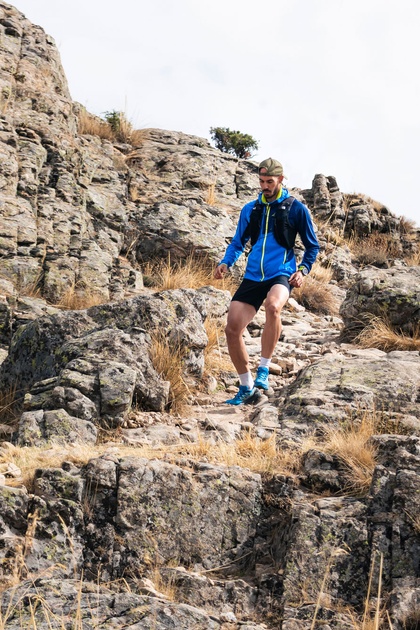
The how-to guide to downhill trail running!
Many runners steer clear of downhill running. However, a healthy musculoskeletal system means you can certainly defy gravity in a safe way. Here are the best tips.
The very thing that drives and motivates cyclists can induce a sense of fear in some runners: downhill trails. After all, long, steep descents put runners at risk of trembling thighs, muscle cramp, stitch or, in the worst case scenario, a fall that results in torn ligaments. Nevertheless, it's possible to learn the technique for downhill running. The most important tips:
- Run actively as much as possible: Active running means consciously placing each foot as you go, not being too relaxed as you run and always keeping a little residual tension in the leg muscles.
- Don't fall into each step: The main error when running downhill is taking long strides and falling into each step by landing on the heel with the leg fully extended. This places a great deal of shock on the joints and muscles and it actually stagnates your running rhythm with each stride. It is better to take short steps and roll loosely over the heel, or better still, over the middle of the foot.
- Adopt a slight “sitting” position for steep descents: When faced with a steep and technically challenging descent, run with your legs slightly apart and assume a more seated position. While this might not look as elegant, you'll be able to react to uneven ground and won’t lose your balance so quickly.
- Breathe consciously: When running quickly downhill, make sure you have a steady breathing rhythm to avoid getting a stitch.
- It’s about running as efficiently as possible rather than running at maximum speed: this is the only way to recover in time for the next ascent. Although there are small gains to be made in terms of overall time, there's plenty more to potentially lose when running downhill.
- Use your eyes: By looking ahead, you're more likely to avoid a dangerous situation. You should always switch between looking closer and further away rather than just at what is right in front of your feet.
- Avoid lightweight shoes: ‘Downhill shoes’ don’t exist. However, if you know you'll be doing lots of steep descents during training or a competition, opt for sturdier shoes. Good cushioning on the mid and forefoot will help to soften the impact. Too much cushioning, particularly in the heel, prevents the necessary control of the foot. A slight heel drop in the shoe allows for more direct contact with the ground and lets you react better to uneven ground and surprises.
Another point about muscle cramps: Even well-trained athletes are prone to cramp during long periods of untypical exercise if the muscles being used aren't well prepared. Downhill running is predestined for muscle pain as the muscles are subjected to major forces, known as eccentric (stopping) forces.
As with all untypical forms of exercise, you should therefore slowly build up your body's exposure to downhill running and only increase the duration gradually. Instead of running the entire time, you might also walk for some of the steeper sections. Alternatively, simply run downhill for some of the trail and take the cable car the rest of the way. For longer descents, it's a good idea to increase the intensity of the training first. For example, you might run three times a week on hilly terrain instead of twice, or dedicate the third session to specific strength training exercises for the thigh and gluteal muscles..
Photo: iStock.com/Victor Lafuente Alonso
This may be of interest for you too


